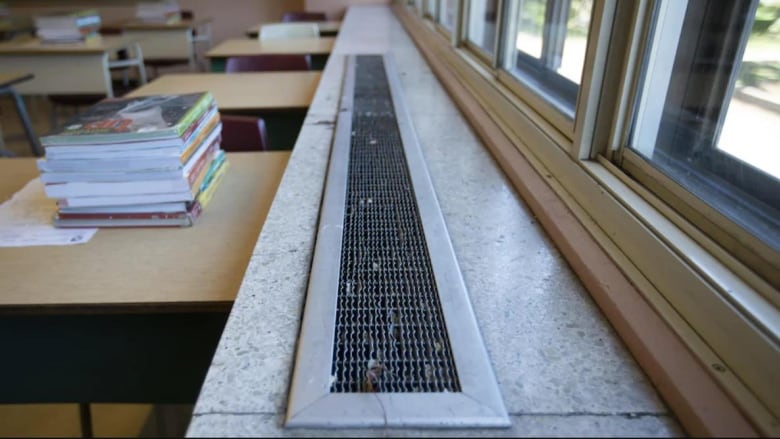How much ventilation makes a Manitoba school safe? Experts say it's a moving target
'Exactly how much ventilation is enough to reduce [exposure] to a practical limit this is somewhat unclear'

Manitoba's provincial government has given guidance on ways to improve air quality in schools during the fourth wave of the COVID-19 pandemic, but experts say our understanding of what is needed to clean the air students and staff breathe continues to evolve.
"There's no doubt that ventilation plays a role in reducing exposure," said Bill Bahnfleth, a professor of architectural engineering at Pennsylvania State University who researches interior quality with a focus on bio-aerosol control.
"Exactly how much ventilation is enough to reduce it to a practical limit this is somewhat unclear."
Bahnfleth is the chair of the epidemic task force of the American Society of Heating, Refrigeration and Air-Conditioning Engineers (ASHRAE), whoserecommendations formed the basis for Manitoba'sguidance onhow schools should operate their ventilation systems.
To reduce the risk of transmission in schools, ASHRAE and other air quality experts say schools should aim to replace the total volume of air in a room five to six times per hour, which is about the rate you would find in a low-level health-care facility.
That can be achieved through any combination of natural ventilation opening windows, for example and mechanical ventilation or filtration systems.
Every school in the province needs to assess its mechanical ventilation and filtration systems, said Marianne Levitsky, an adjunct lecturer at the University of Toronto and the president of Workplace Health Without Borders, a non-profit that assesses and controls work-related hazards in developing countries.
Schools need to firstmeasure how much natural air flow the building has and"find out how much air is moving around, how much of it is fresh air, and what kind of filtration is there," shesaid.
"Once you know that, you can measure the size of the room and it's going to tell you a lot about whether you have good ventilation."
Changing standards
No one has pinned down the specific concentration of aerosols considered dangerous.
"If we knew that, our lives would be a lot easier," said Levitsky.
Schools can do their own assessments using tools published by Harvard University's Healthy Buildings initiative.
"If you're in high school, you can get the math students to do that and you can figure out if your air changes per hour are meeting those guidelines," Levitsky said.
Manitoba's recommendations call for schools to flush the air for two hours before and after people enter the building, but Bahnfleth says that is based on an older recommendation from ASHRAE.
"We think now that really the main concern with clearing spaces is between occupancy periods, when you're trying to turn the space over quickly," he said.
The society now recommends three air changes roughly 30 to 36 minutes between classes, instead of two hours before and after occupancy.
"What we've done ... is to try to identify things that are the most effective and have the least impact on energy use and operating costs that can be implemented easily," Bahnfleth said.
Five to six air changes per hour is a target, not a minimum, said Jeffrey Siegel, an air quality expert in the department of civil and mineral engineering at the University of Toronto.
Filtration vs. ventilation
The air changes can come either from external air being brought inside or by using a high-efficiency filter to clean the air.
The filtration method is important in places with extreme climates, when a lot of energy is spent conditioning the air, Siegel said.
Retrofitting old buildings with new heating, ventilation and air conditioning (HVAC) systems can be costly and disruptive, so Seigel recommends using portable high-efficiency particulate air (HEPA) filters.
However, teachers have to be trained to use them.
"My daughter came home from school one day and said, 'Hey, we got a HEPA filter in our classroom,'" he said.
"And then I asked her about that three or four days later she's like, 'Oh yeah, we turned it offbecause it was too noisy.'"
Teachers need to know when to adjust the filter, Seigel said, suggesting they turn it up at times like lunch period, when kids have their masks off, and then turning it down at times when minimal noise is required.
Mechanical ventilationpreferred: province
A spokesperson for the provincial government said that mechanical ventilation remains the preferred method for cleaning the air.
"It is important for schools to consult an experienced HVAC design professional to assess indoor spaces and assist in identifying ventilation needs," the spokesperson said in an email statement.
"Portable air cleaners or air purifiers (HEPA) may be considered as a supplement to ventilation, or if there is limited outdoor air exchange."
Manitoba's guidelines don't specify a minimum standard for filters, stating that they should be properly fitted with no air bypass, and inspected and changed regularly.
ASHRAE recommends, at a minimum,MERV-13 filters (MERV standing for "minimum efficiency reporting value") which areenough to remove aerosols from the air.
Proper ventilation and filtration form a layer of protection against COVID-19 in schools, Bahnfleth said, but are only part of the solution.
Schools also need to emphasize vaccinations and rapid testing, to prevent infected people from entering the school in the first place, as well as physical spacing and masks to limit exposure.
"Something I try to fight against, when talking with people about risk mitigation, is getting really myopically focused on one layer of control," said Bahnfleth.












_(720p).jpg)


 OFFICIAL HD MUSIC VIDEO.jpg)
.jpg)



























































































